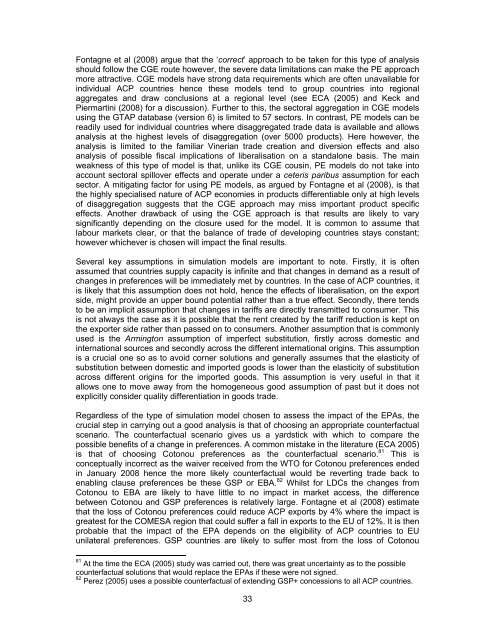EPA Review Annex Documents - DFID
EPA Review Annex Documents - DFID
EPA Review Annex Documents - DFID
Create successful ePaper yourself
Turn your PDF publications into a flip-book with our unique Google optimized e-Paper software.
Fontagne et al (2008) argue that the ‘correct’ approach to be taken for this type of analysis<br />
should follow the CGE route however, the severe data limitations can make the PE approach<br />
more attractive. CGE models have strong data requirements which are often unavailable for<br />
individual ACP countries hence these models tend to group countries into regional<br />
aggregates and draw conclusions at a regional level (see ECA (2005) and Keck and<br />
Piermartini (2008) for a discussion). Further to this, the sectoral aggregation in CGE models<br />
using the GTAP database (version 6) is limited to 57 sectors. In contrast, PE models can be<br />
readily used for individual countries where disaggregated trade data is available and allows<br />
analysis at the highest levels of disaggregation (over 5000 products). Here however, the<br />
analysis is limited to the familiar Vinerian trade creation and diversion effects and also<br />
analysis of possible fiscal implications of liberalisation on a standalone basis. The main<br />
weakness of this type of model is that, unlike its CGE cousin, PE models do not take into<br />
account sectoral spillover effects and operate under a ceteris paribus assumption for each<br />
sector. A mitigating factor for using PE models, as argued by Fontagne et al (2008), is that<br />
the highly specialised nature of ACP economies in products differentiable only at high levels<br />
of disaggregation suggests that the CGE approach may miss important product specific<br />
effects. Another drawback of using the CGE approach is that results are likely to vary<br />
significantly depending on the closure used for the model. It is common to assume that<br />
labour markets clear, or that the balance of trade of developing countries stays constant;<br />
however whichever is chosen will impact the final results.<br />
Several key assumptions in simulation models are important to note. Firstly, it is often<br />
assumed that countries supply capacity is infinite and that changes in demand as a result of<br />
changes in preferences will be immediately met by countries. In the case of ACP countries, it<br />
is likely that this assumption does not hold, hence the effects of liberalisation, on the export<br />
side, might provide an upper bound potential rather than a true effect. Secondly, there tends<br />
to be an implicit assumption that changes in tariffs are directly transmitted to consumer. This<br />
is not always the case as it is possible that the rent created by the tariff reduction is kept on<br />
the exporter side rather than passed on to consumers. Another assumption that is commonly<br />
used is the Armington assumption of imperfect substitution, firstly across domestic and<br />
international sources and secondly across the different international origins. This assumption<br />
is a crucial one so as to avoid corner solutions and generally assumes that the elasticity of<br />
substitution between domestic and imported goods is lower than the elasticity of substitution<br />
across different origins for the imported goods. This assumption is very useful in that it<br />
allows one to move away from the homogeneous good assumption of past but it does not<br />
explicitly consider quality differentiation in goods trade.<br />
Regardless of the type of simulation model chosen to assess the impact of the <strong>EPA</strong>s, the<br />
crucial step in carrying out a good analysis is that of choosing an appropriate counterfactual<br />
scenario. The counterfactual scenario gives us a yardstick with which to compare the<br />
possible benefits of a change in preferences. A common mistake in the literature (ECA 2005)<br />
is that of choosing Cotonou preferences as the counterfactual scenario. 81 This is<br />
conceptually incorrect as the waiver received from the WTO for Cotonou preferences ended<br />
in January 2008 hence the more likely counterfactual would be reverting trade back to<br />
enabling clause preferences be these GSP or EBA. 82 Whilst for LDCs the changes from<br />
Cotonou to EBA are likely to have little to no impact in market access, the difference<br />
between Cotonou and GSP preferences is relatively large. Fontagne et al (2008) estimate<br />
that the loss of Cotonou preferences could reduce ACP exports by 4% where the impact is<br />
greatest for the COMESA region that could suffer a fall in exports to the EU of 12%. It is then<br />
probable that the impact of the <strong>EPA</strong> depends on the eligibility of ACP countries to EU<br />
unilateral preferences. GSP countries are likely to suffer most from the loss of Cotonou<br />
81 At the time the ECA (2005) study was carried out, there was great uncertainty as to the possible<br />
counterfactual solutions that would replace the <strong>EPA</strong>s if these were not signed.<br />
82 Perez (2005) uses a possible counterfactual of extending GSP+ concessions to all ACP countries.<br />
33
















